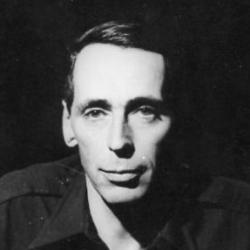Oliver La Farge facts for kids
Quick facts for kids
Oliver La Farge
|
|
|---|---|
 |
|
| Born | Oliver Hazard Perry La Farge December 19, 1901 New York City, U.S. |
| Died | August 2, 1963 (aged 61) Santa Fe, New Mexico, U.S. |
| Occupation | novelist, anthropologist |
| Education | Harvard University (BA, MA) |
Oliver La Farge (born December 19, 1901 – died August 2, 1963) was an American writer. He was also an anthropologist, which means he studied human cultures and societies.
In 1925, he explored ancient Olmec sites in Mexico. Later, he studied more sites in Central America and the American Southwest. La Farge wrote many books and stories. He wrote over 15 scholarly works, mostly about Native American cultures. He also wrote several novels. One of his most famous novels was Laughing Boy (1929). This book won the Pulitzer Prize, a very important award for writers. He also wrote short stories for magazines like The New Yorker.
His most important works, both fiction and non-fiction, focused on Native American culture. He knew a lot about the Navajo people. He could even speak some of their language. The Navajo people gave him the nickname 'Anast'harzi Nez', which means "Tall Cliff-Dweller."
Contents
Early Life and Education
Oliver La Farge was born in New York City. He grew up in Newport, Rhode Island. His father, Christopher Grant La Farge, was a famous architect. An architect designs buildings. His mother was Florence Bayard Lockwood. Oliver's older brother, Christopher La Farge, also became a writer.
Oliver La Farge went to Harvard University. He earned his first degree there in 1924. He later earned a master's degree from Harvard in 1929.
Career as a Writer and Anthropologist
La Farge worked as both a writer and an anthropologist. In 1925, he traveled with a Danish archeologist named Frans Blom. An archeologist studies old human history by digging up sites. They went to a place now known as the Olmec heartland in Mexico. There, they rediscovered important ancient ruins. These included San Martin Pajapan Monument 1 and La Venta. La Venta was one of the main centers of the Olmec civilization.
After moving to Santa Fe, New Mexico in 1933, La Farge spent a lot of time studying Native American peoples. He also worked to protect their rights. He was the president of the Association on American Indian Affairs for many years. This group helps Native American communities.
During World War II, La Farge served in the U.S. Air Transport Command. He helped with the Battle for Greenland. He also co-wrote a book about this battle called War Below Zero: The Battle for Greenland (1944).
Family Life
Oliver La Farge married Wanden Matthews. They had two children: a son named Oliver Albee La Farge and a daughter named Povy. They moved to Santa Fe in 1933. However, Wanden did not like the area, and they divorced in 1937.
Their son, Oliver Albee, later changed his name to Peter La Farge. Peter became a well-known folksinger and songwriter in New York City. He performed in the 1950s and 1960s. Some of his most popular songs were about Native American themes. One song, "As Long as the Grass Shall Grow," was named after one of his father's books.
La Farge married a second time to Consuelo Otile Baca. They had a son named John Pendaries "Pen" La Farge. Oliver La Farge's non-fiction book Behind the Mountains (1956) is based on his memories of Consuelo's family. They were ranchers in northern New Mexico. He also wrote a regular column for The New Mexican newspaper in Santa Fe. Some of these columns were later put together in a book called The Man with the Calabash Pipe (1966).
Oliver La Farge passed away in Santa Fe in 1963. He was 61 years old.
Legacy and Honors
- He won the Pulitzer Prize for fiction for his novel Laughing Boy in 1929.
- A branch of the Santa Fe Public Library system is named the "Oliver La Farge" branch in his honor.
Works
Non-fiction Books
- Tribes and Temples (with Frans Blom), 1926-1927
- The Year Bearer's People (with Douglas Byers), 1931
- Introduction to American Indian Art (with John Sloan), 1931
- An Alphabet for Writing the Navajo Language, 1940
- As Long As The Grass Can Grow - Indians Today, with photographs by Helen M. Post, 1940
- The Changing Indian (editor), 1942
- War Below Zero: The Battle for Greenland (with Colonel Bernt Balchen and Major Corey Ford), 1944
- Santa Eulalia: The Religion of a Cuchumatan Indian Town, 1947
- The Eagle in the Egg, 1949
- Cochise of Arizona, 1953
- The Mother Ditch, 1954
- A Pictorial History of the American Indian, 1956
- Behind the Mountains, 1956
- Santa Fe: The Autobiography of a Southwestern Town (with Arthur N. Morgan), 1959
Fiction and Personal Writings
- Laughing Boy (1929), a novel that was made into a movie in 1934.
- Sparks Fly Upward (1931), a novel.
- Long Pennant (1933), a novel.
- All the Young Men (1935), a collection of short stories.
- The Enemy Gods (1937), a novel.
- The Copper Pot (1942), a novel.
- Raw Material (1945), his memories.
- A Pause in the Desert (1957), a collection of short stories.
- The Door in the Wall (1965), a collection of short stories.
- The Man With the Calabash Pipe (1966), collected newspaper columns.
Translations
- A Man's Place (1940), he translated this book by Ramón J. Sender.

